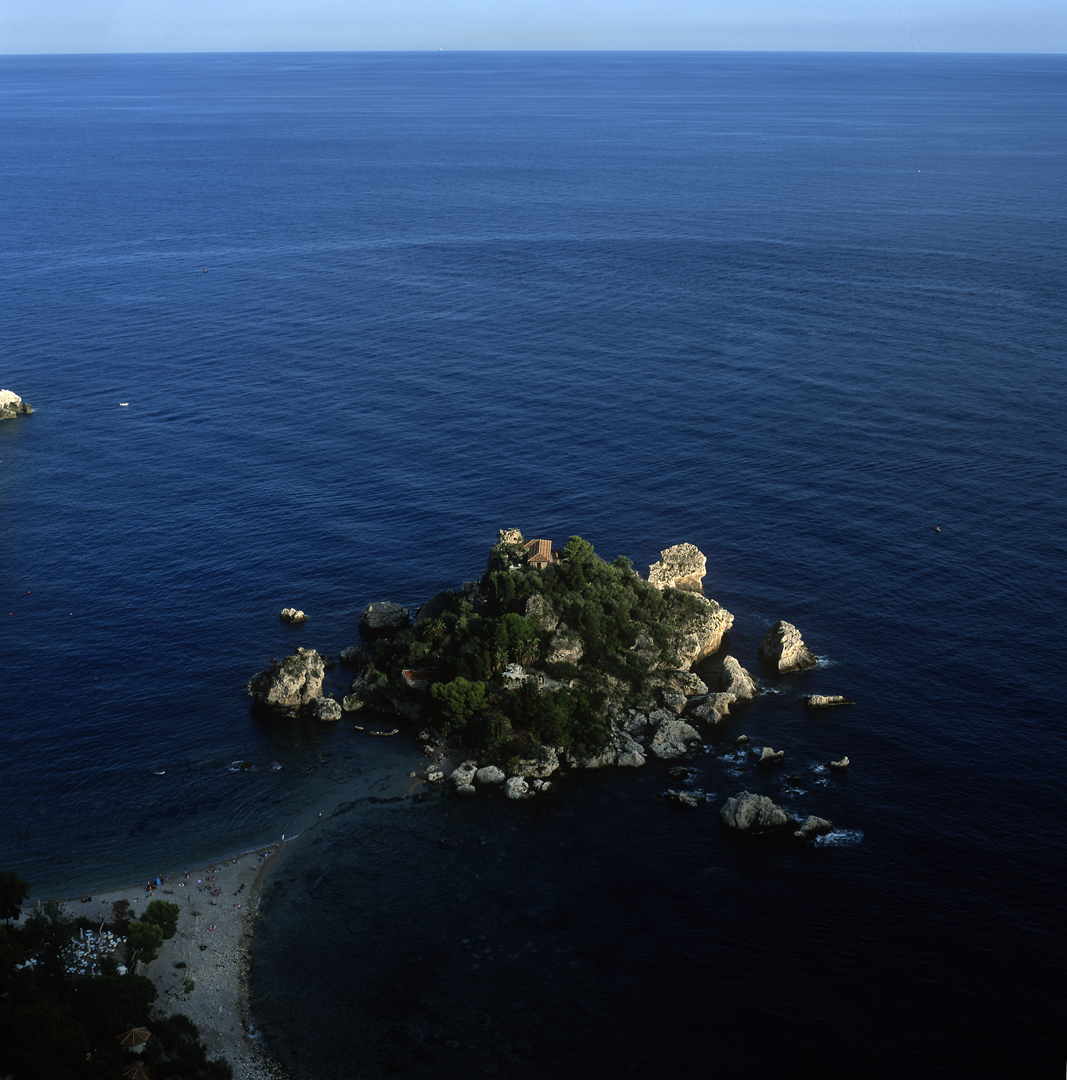Taormina sits on its craggy outcrop looking out over the Strait of Messina, in the shadow of Mount Etna, with implausibly beautiful views. The food there is good too.
This is the final post based on material from a tour of Sicily a few years ago, at least until we are able to return. This post will be a bit more of a travelogue and a bit less didactic than some of my recent posts. You can find the earlier instalments here:
- Il Miracolo di San Bagagio
- The Wild West of Sicily
- Norman Sicily
- Montalbano Country
- Piazza Armerina, Morgantina and Siracusa
We had been basing ourselves near the town of Ragusa – one of several Baroque gems in southeast Sicily and in the heart of Montalbano country. Apart from our return to Palermo and its terrifying traffic, our last stop was to be Taormina on the east coast.
The drive to Taormina was pretty easy. We took a main road northeast from Ragusa until we hit the east coast near Catania, and then took the coastal motorway north. And from about halfway into the trip, Etna was there, first dominating the horizon to our north, then a huge presence on our left as we headed up the coast. The atmospheric conditions around the top change constantly – one moment it will be covered in cloud, and ten minutes later it will be clear. But even at its clearest there is always a plume of smoke and vapour around the crater.
We had a 2pm rendezvous arranged with the parents of the lady who owns the flat we would be renting for three days, and we arrived in Taormina at about 12.30, so with an hour and a half to kill we stopped for lunch at the first restaurant we saw after leaving the motorway. Not much on the menu was available at lunchtime in the off season, and what there was was only OK, but any shortcomings were amply compensated by the view. We were looking northeast up the coast and across the straits of Messina. It was sunny and clear enough to see the mountains of Calabria on the other side.
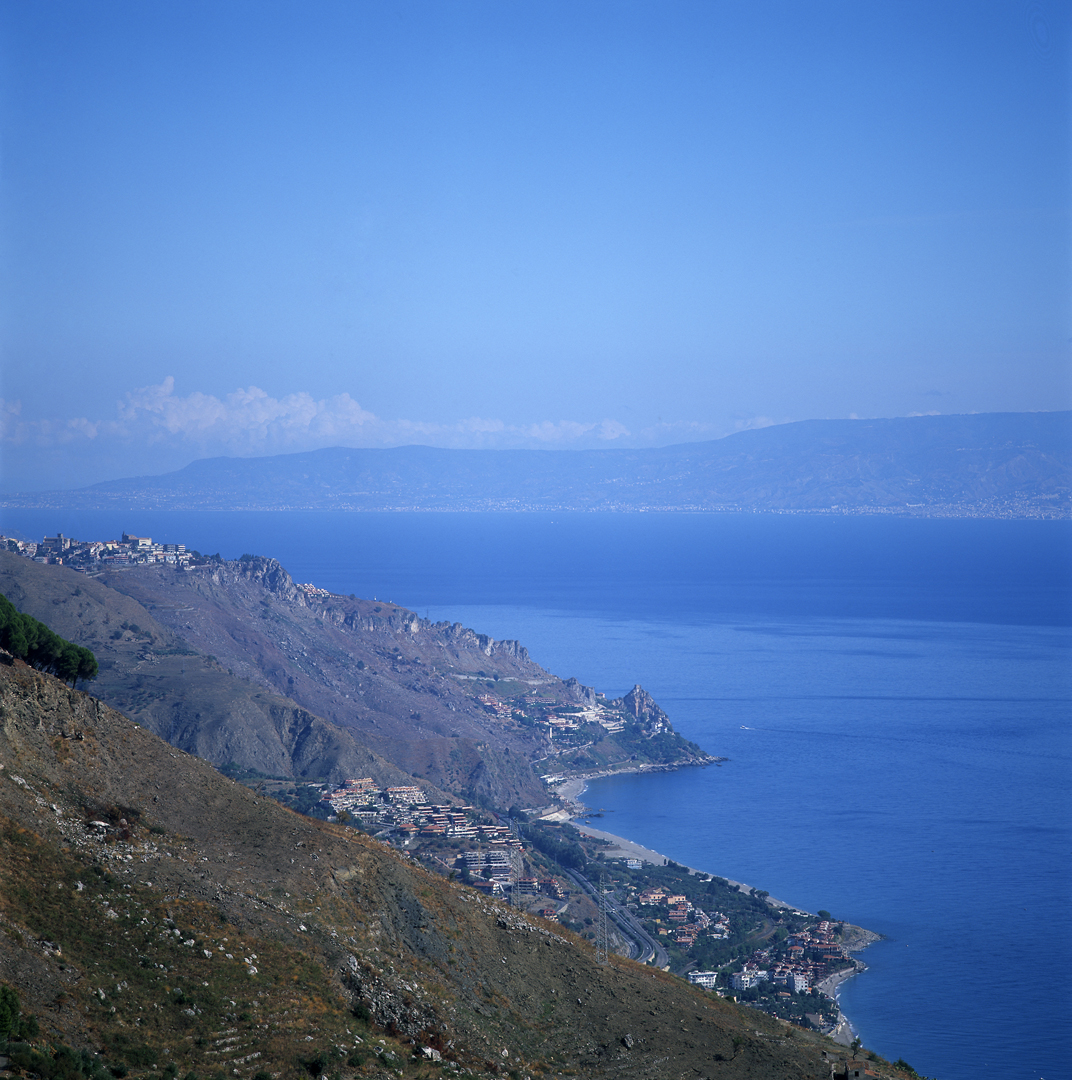
The rendezvous went fine. The front door of the flat opened straight onto a street (not even a front doorstep) and the street itself was too narrow for a sane Australian to attempt to park. But I’d been in Italy long enough by then to know what to do – park as close as possible to the wall on the opposite side, put the hazard flashers on and let the traffic find its way around me as best it might while I unloaded the car.
Then the proper thing to do would have been to drive to the multi-storey municipal paid car park from which it would have been a twenty-minute walk back up innumerable steep flights of steps. Everywhere else is strictly residents parking only. Of course no right-thinking southern Italian would pay for parking if an alternative were available, and I sought our landlady’s dad’s advice. He recommended a piazza about five minutes walk away where they always parked (they were from out of town themselves) and where he claimed they never got booked. Time would tell whether this applied to us but after 24 hours of a guilty Anglo-Saxon conscience I had yet to be booked, clamped or towed away. I was encouraged by the memory of the time near Amalfi where on the recommendation of our landlord I parked for a week in a two-hour car park without any problems. There is no substitute for local knowledge.
After settling in we headed down into the main part of town. Taormina (ancient Greek Tauromenion) being of Greek origin is of course on top of a steep hill, in this case jutting out from the steeper slopes that come down from the mountains to the sea along here. Apparently this particular hill is composed of especially solid rock, which is why despite so many centuries of seismological and vulcanological excitement there are still Greek, Roman and medieval buildings, including a particularly fine amphitheatre which we were yet to visit. From Taormina’s crag, you can look south down the coast towards Catania, and immediately below you is a picture-perfect horseshoe-shaped bay in which is a pretty island called appropriately if unimaginatively Isola Bella (Pretty Island).
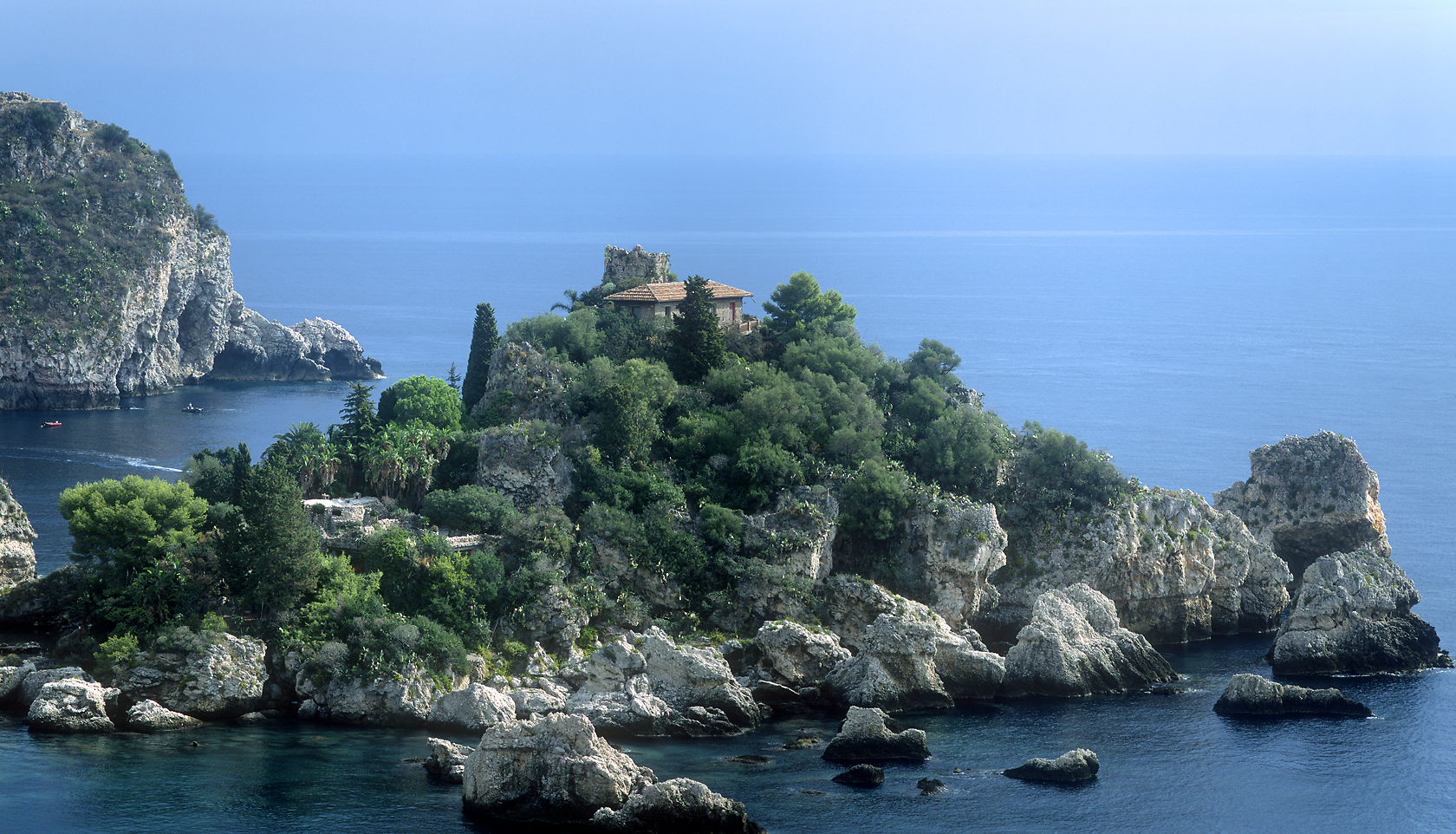
Being for much of the early 20th Century both spectacularly beautiful and cheap, Taormina housed a succession of northern European artists, bohemians and pederasts escaping creditors and the authorities back at home, and soaking up the sun, wine and local youth. One German minor aristocrat specialised in taking photographs of the local shepherd boys in “classical” poses that would get him arrested today. But such is the cult of even peripheral celebrity that you can buy editions of his photographs (sealed in plastic) in the souvenir shops, and the piazza in which I was illegally parked was named after him.
D.H. Lawrence wrote Sea and Sardinia here but then he also wrote Kangaroo near Wollongong so I’m not sure what that proves.
Being steep meant that for us to get down to the main drag we needed to go down a hundred or two stairs, or along a considerably longer road with a dozen switchback bends (and with no footpath). Once down there one was in no doubt that Taormina is a real tourist town. At least half the shops were open during the afternoon when no self-respecting Sicilian would go shopping. And what was on offer was mostly souvenirs, crafts, and local wine, sweets and gastronomia. The most expensive cafe in town with the best view (much appreciated by Winston Churchill, we are told) was called the Café Wunderbar and like any decent tourist town anywhere, there was a fake Irish pub. Blokes in fancy dress armed with mandolins and accordions would go up to those tourists who had unwisely chosen the tables nearest the street and play O Sole Mio non-stop until bribed to go away.
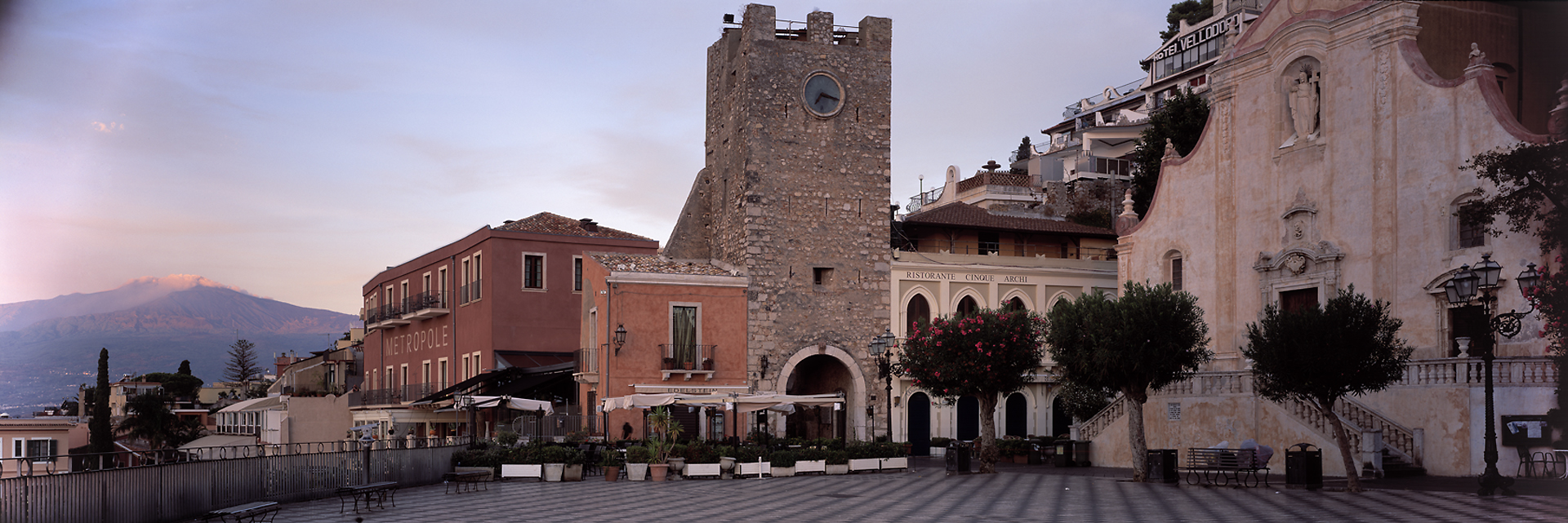
Many of the tourists came from cruise ships docked in Catania. From about 9.30 in the morning till the last tour bus departed in the evening the main street was shoulder to shoulder with them, many in tour groups led by guides holding aloft their totems, often a half-opened umbrella. Indeed Lou and I were speculating that I should try half-opening my umbrella, holding it aloft, marching the length of the main street and seeing how many foreigners I had picked up along the way.
But as we have noted before, the thing about tourist traps is that they attract tourists for good reasons, the principal one being that they are in very beautiful places. Even one afternoon, as the weather deteriorated, some rain fell, thunder rolled and lightning played around the upper slopes of Etna, we were very happy sitting at our roadside cafe (in a side street where the risk of busker attack was lower). After a big plate of pasta each at lunch neither of us felt like a full meal and so in the evening we sat outside an enoteca and just had a glass of wine each and shared a plate of antipasto. By the time we were back up to the main street the passegiata was under way, when every Italian puts on nice clothes and wanders up and down the street chatting to friends. In places like Taormina they are joined by sunburnt Brits in shorts and sandals, loud Americans and Germans, Japanese (and increasingly Chinese) in expensively branded Italian stuff they have paid too much for, and of course us.
Just to make it all a bit more memorable, the Targa Florio classic car rally was in town that night, and the main street which is normally closed to traffic was periodically host to modern Ferraris driven by very rich Japanese living out their life’s fantasies, and a range of vintage sports cars including, to my delight, a number of Alfa Romeos from the 1950s and 60s.
The next day we spent in Taormina again. The weather was patchy for photography in the morning, and overcast in the afternoon and evening. Very early we went down to the municipal gardens which have a great view south to Etna and along the coast, but which are also very nice in their own right. The light was pretty transient but I only needed it to be good for 1/4 of a second at f.32 and I took a few large format shots. It turned out that the gardens were established by an aristocratic English lady who had been a lady-in-waiting to Queen Victoria but who got her marching orders after a dalliance with the Prince of Wales. She then decamped to Sicily, married a respectable local doctor, and laid out the public gardens, as one does in such circumstances.
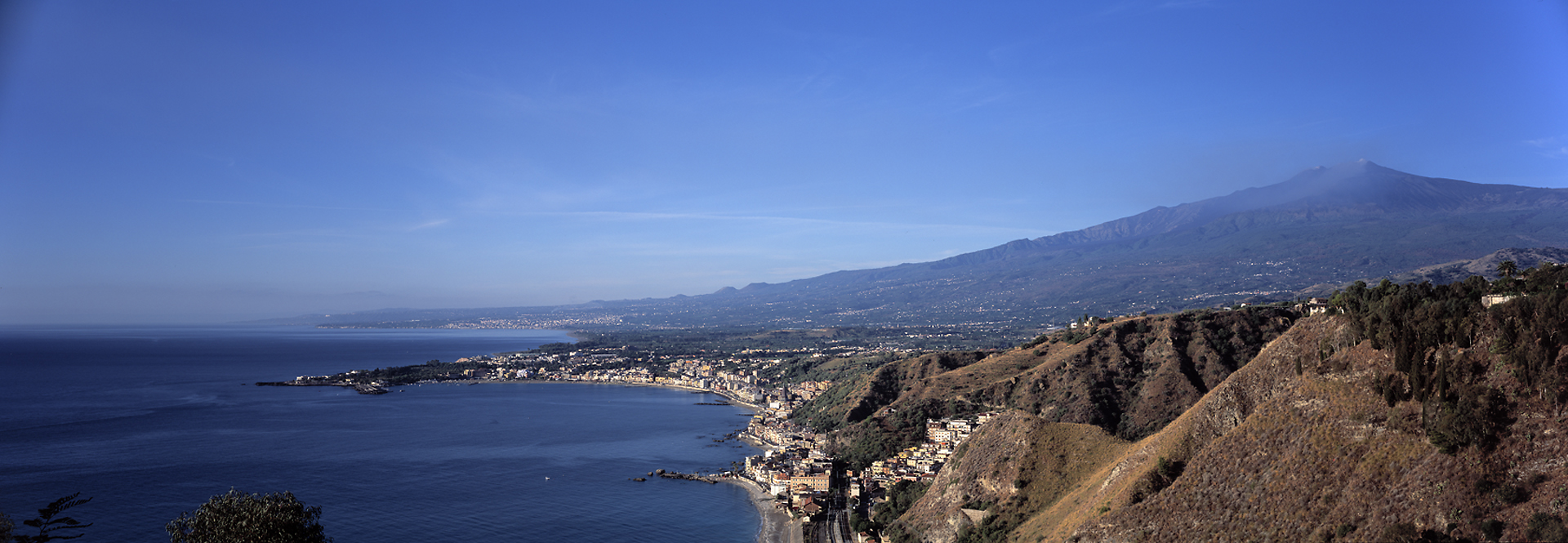
After that I hiked back up to the flat to divest myself of 25 kilos or so of camera gear while Lou stayed in town. I returned to meet up with Lou and we had a late roadside breakfast outside a pastry and sweet shop. We caught the cable car down to sea level and wandered along beside the coast where we had some excellent views of Isola Bella. On the way back we stopped at a bar overlooking the bay and had very nice granitas – lemon for me, mandarin for Lou. Back up in town again we decided that we would go home for lunch, and bought some prosciutto and bread in the little supermarket in the piazza of the German pederast where I was illegally parked (but still without retribution).
Next morning dawned fine and completely cloudless so we sprinted off back down into town, or at least made as rapid progress as one can with 25 kg of large format camera gear, in order to be at the entrance to the Greek theatre for when it opened at 8am. We were, it wasn’t. Which is to say that the advertised 8am opening time only applies in summer. In October it opens at 9. No matter, I headed back to the municipal gardens to retake the previous day’s photos in much better light. Eventually we made it back to the theatre, getting in with the first crowds of the morning but before the first tour buses arrived.
The so-called Greek theatre was actually extensively remodelled by the Romans, which the classier sort of guide book rather sniffs at, suggesting that this sort of modernisation is a terrible thing. Well, it may be, but actually the Roman bits didn’t look all that bad to our debased tastes and on a high headland, on a sunny morning, with Etna obligingly smoking away in the background it was great.
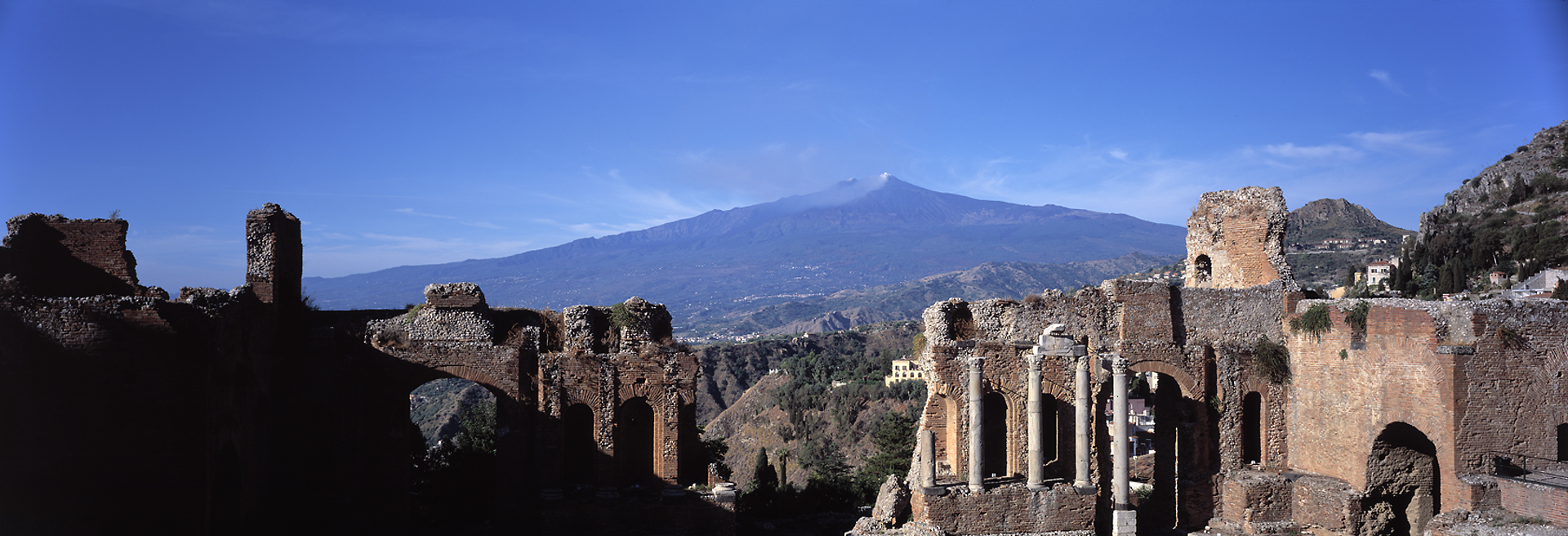
I got some good large format photos, although we had to deal with something that one tends to encounter in Italy – a couple of officials spotted that I was using a tripod and struggled up the steps of the theatre like worried cinema usherettes to tell us that this wasn’t allowed. I always observe bans on tripods when they are shown, but in this case there were no such signs. I suspect that there is actually a ban on professional photography without permits, and the officials assume that tripod means professional. Needless to say I had chosen a spot well away from anyone else so the tripod wasn’t impeding anyone.
Anyway, it took them a couple of minutes to struggle up to where we were, by which time I had taken all the photographs I wanted, and had largely finished packing up. The conversation went along these lines: Them: “professional photography isn’t allowed”. Me: “That’s OK then, I’m not a professional. This is my hobby.” Them: “It still isn’t allowed.” Lou: “Why?”. Them: “Because of the regulations.” Lou laughs. Them: “A camera by itself is OK, but not this thing – what’s it called?” Me: “In Italian it’s called a treppiedi. In English it’s called a tripod.” Them: “Ah, TRIPOD, thanks.” After which they left. It’s tiresome but people write to photography magazines about it all the time – petty officialdom everywhere equates tripods with professionals, and assumes it must not be allowed. Anyway, the outcome was that I got my photographs. I once had a conversation like that in Rome, where I actually triggered the shutter while talking to the policeman. He was asserting that tripods were a threat to public safety – I was suggesting that at 6am when he and I were the only ones in the piazza, the threat was probably manageable.
After our successful encounter with Sicilian bureaucracy we came back to the flat and headed to the car (still unbooked) for what we had planned to be a driving day, where we would go all the way around Etna. But first we thought we would follow our road all the way up to a village called Castelmola which is perched on a crag several hundred feet higher than Taormina. When we got there I had the agreeable experience of parking legally and then walking past the village policeman with a clear conscience. More importantly, when we emerged from the municipal car park we realised that we were in a very beautiful place, high up, on a clear sunny day, with spectacular views in every direction, not least to Etna to the south, but also with very clear views across the Strait of Messina to Reggio Calabria (the “toe” of Italy) on the other side.
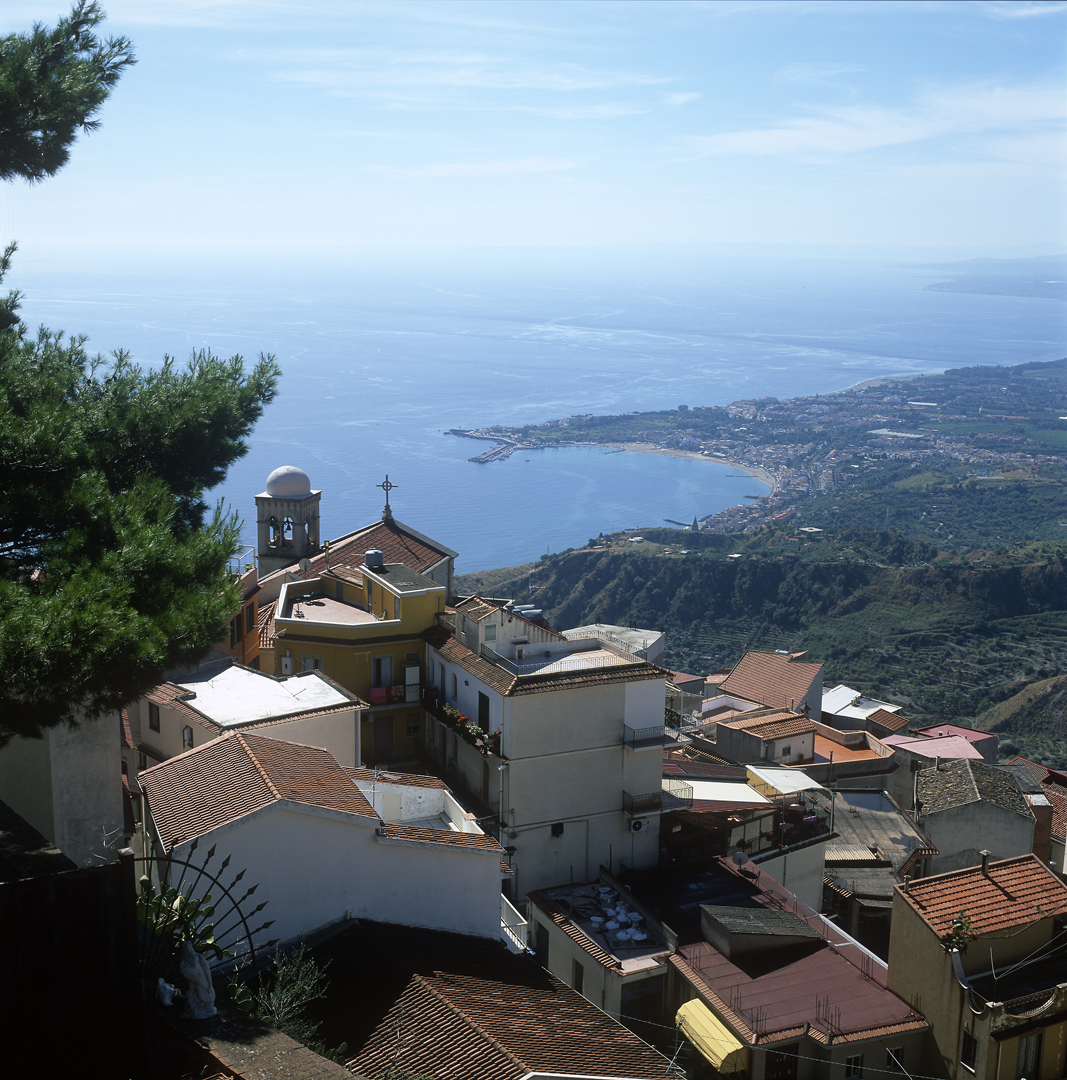
So we decided to go no further. After spending some time at the castle at the very top of the mountain, we came back down to the village and found a bar with a rooftop terrace, with a view of – yes – Etna. The bar was run by a delightful old chap – I asked him for a glass of local white wine and it arrived in a large beer tankard which pretty much put paid to any residual idea that I might go for a long drive afterwards. For almost an hour we sat on the terrace, nursed our drinks and watched Etna.
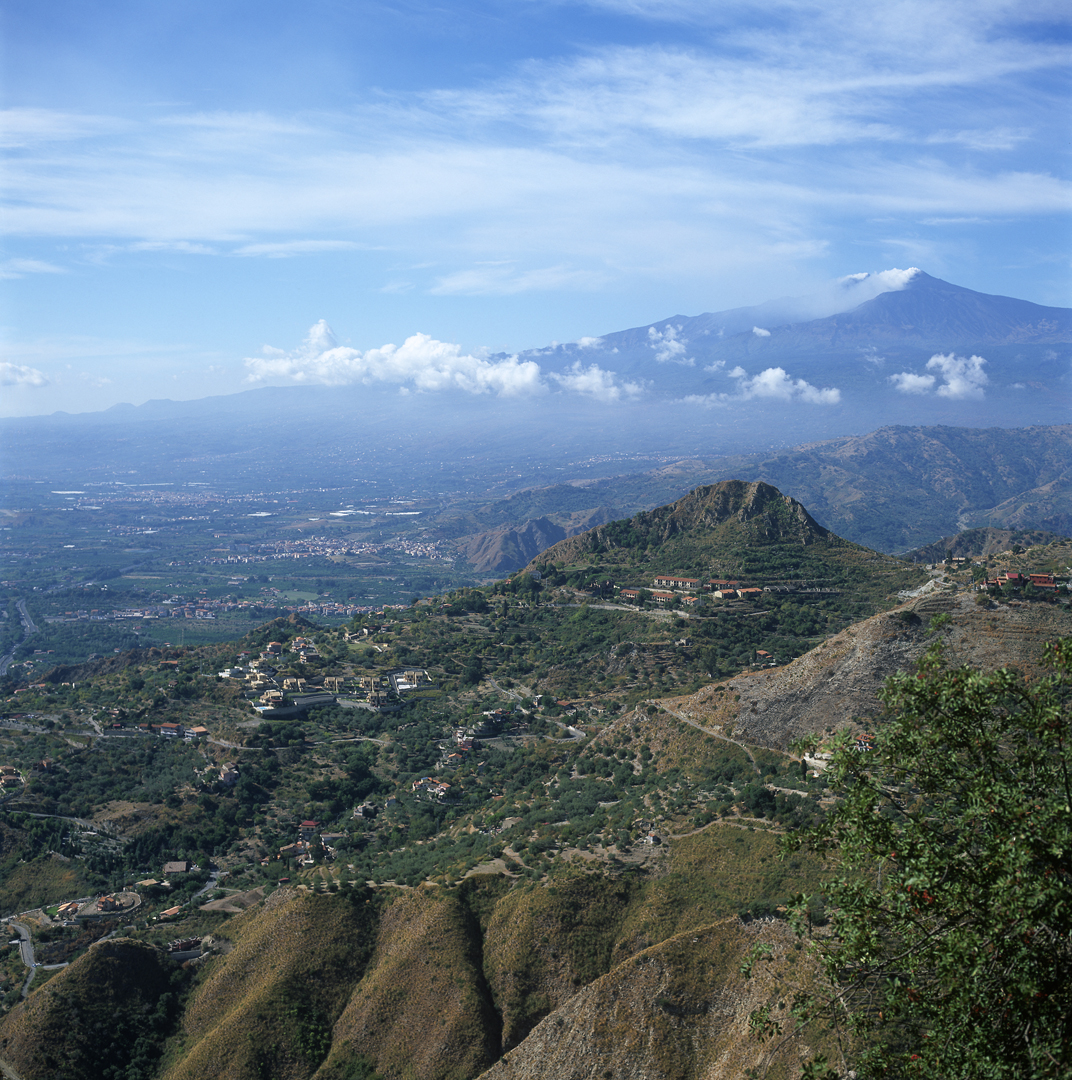
It changes constantly. At first there was no cloud apart from the plume of smoke and vapour coming from the crater. Then as the day warmed up clouds would form downwind of the summit. They would build up and hide the summit. Then, just when we had decided that was it for the day, suddenly it would clear. But always there was the plume of smoke.
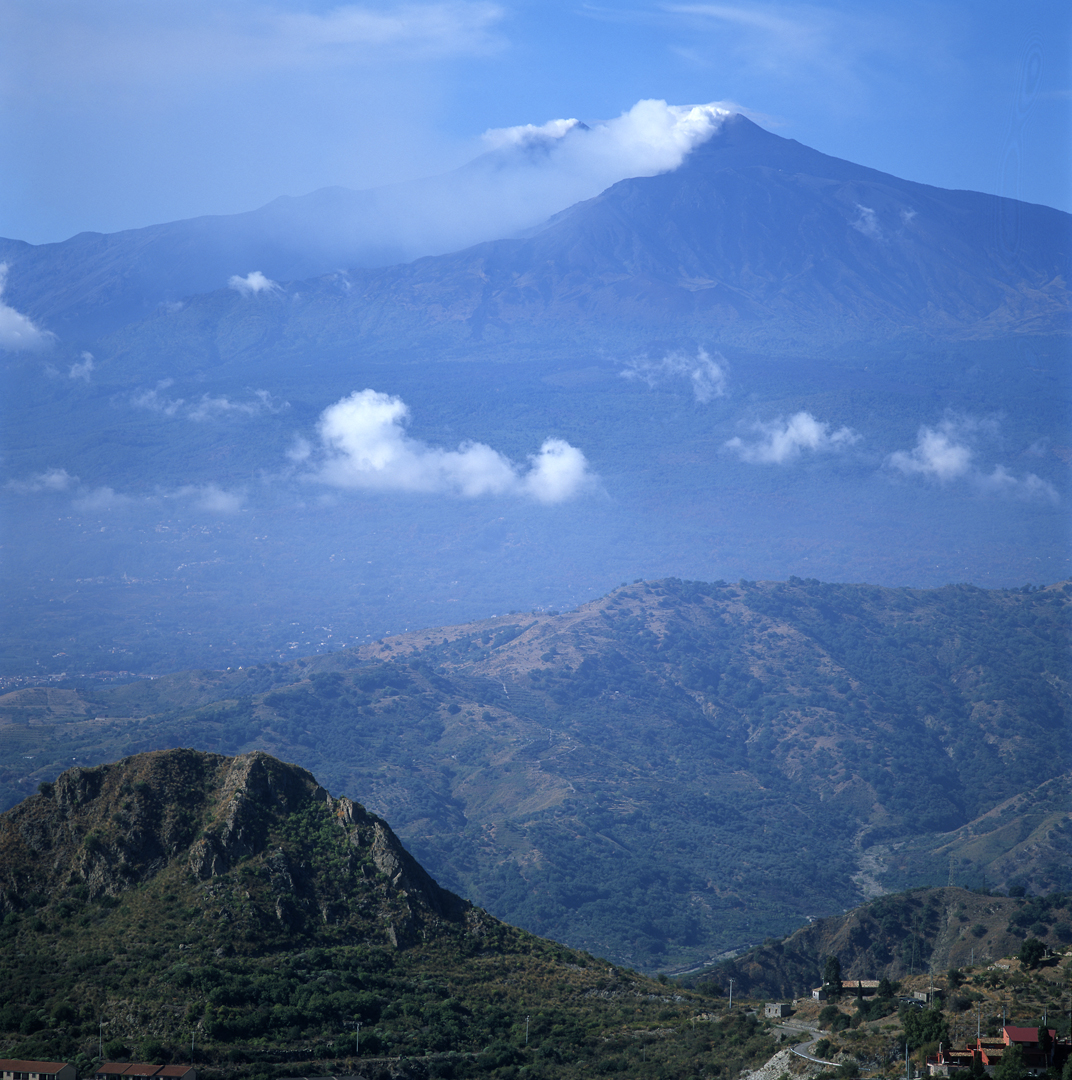
Then we went down the road a bit to a restaurant with a view of a certain large volcano, and where the lunch was adequate but the view was fantastic.
After our drink we came back down, parked the car illegally again, dropped the large format camera gear at the flat, then went down to the belvedere with my Hasselblad where I took a couple of shots of Isola Bella from a different angle. Then – via the internet bar where Lou had a raspberry granita with cream, and a shop which sold takeaway arancini in many varieties – back home to start packing for the trip to Palermo the next day.
